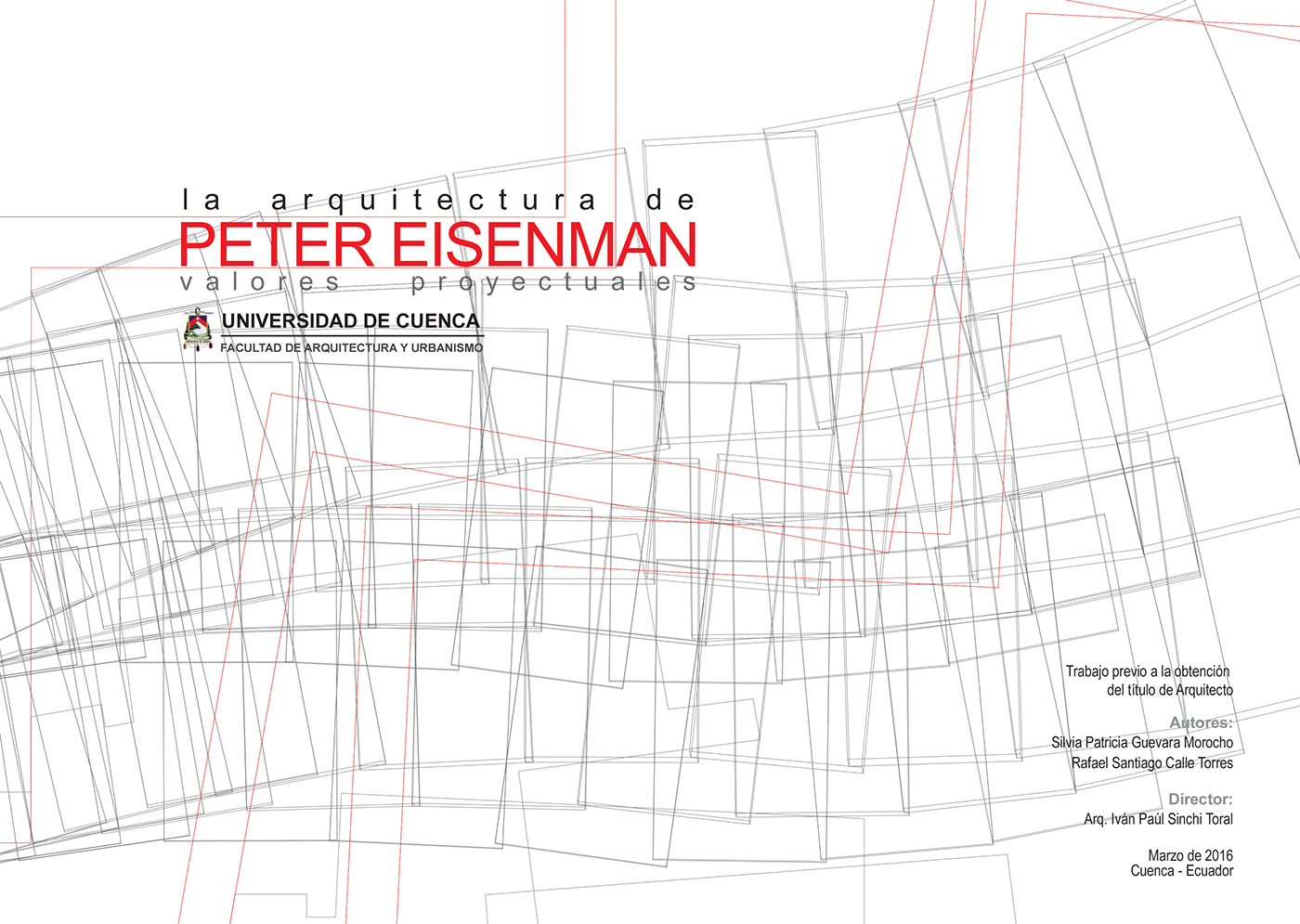
http://dspace.ucuenca.edu.ec/handle/123456789/23767
La investigación presente analizó el desarrollo de la serie de
valores que se ponen de manifi esto en las últimas décadas
del siglo XX en la arquitectura, que surgió del abandono del
formalismo a la consideración del concepto. Para entender qué la
motivó, se estudió “La arquitectura de Peter Eisenman”, referente
de este período. Se consideró las posibles infl uencias estéticas
y artísticas que antecedieron al pensamiento contemporáneo.
Partiendo desde las teorías kantianas pasando por la lingüística,
la semiótica, el posestructuralismo francés y la deconstrucción,
desembocando en las prácticas artísticas del siglo XX como el
Neoplasticismo, el Minimalismo, la Abstracción excéntrica y el
arte Conceptual. Con estas bases se buscó entender el trabajo
de Eisenman el cual se ha dividido en tres puntos: visión, formafi
gura y herramientas gráfi cas. Se concluye con la selección de
tres obras arquitectónicas como son: Casa VI (1972-1975), Centro
Aronoff para Diseño y Arte (1988-1996) y Memorial a los judíos
caídos de Europa (1998-2005) correspondientes a las diferentes
etapas de proyección del autor. Derivando en la importancia que
adquiere –para Eisenman– la fi gura como semántica, con la cual
buscó un diálogo de acción y reacción en las dinámicas del objeto
y las sensaciones del sujeto. Reconociendo que su proceso de
proyección se basó en la determinación de una intención, la
generación de la geometría, la adaptación de: función, estructura
portante y elementos estandarizados de la arquitectura.
Caracterizando al proceso desde el preestablecimiento de
una fi gura que amplía las posibilidades de la interpretación del
espacio arquitectónico.
valores que se ponen de manifi esto en las últimas décadas
del siglo XX en la arquitectura, que surgió del abandono del
formalismo a la consideración del concepto. Para entender qué la
motivó, se estudió “La arquitectura de Peter Eisenman”, referente
de este período. Se consideró las posibles infl uencias estéticas
y artísticas que antecedieron al pensamiento contemporáneo.
Partiendo desde las teorías kantianas pasando por la lingüística,
la semiótica, el posestructuralismo francés y la deconstrucción,
desembocando en las prácticas artísticas del siglo XX como el
Neoplasticismo, el Minimalismo, la Abstracción excéntrica y el
arte Conceptual. Con estas bases se buscó entender el trabajo
de Eisenman el cual se ha dividido en tres puntos: visión, formafi
gura y herramientas gráfi cas. Se concluye con la selección de
tres obras arquitectónicas como son: Casa VI (1972-1975), Centro
Aronoff para Diseño y Arte (1988-1996) y Memorial a los judíos
caídos de Europa (1998-2005) correspondientes a las diferentes
etapas de proyección del autor. Derivando en la importancia que
adquiere –para Eisenman– la fi gura como semántica, con la cual
buscó un diálogo de acción y reacción en las dinámicas del objeto
y las sensaciones del sujeto. Reconociendo que su proceso de
proyección se basó en la determinación de una intención, la
generación de la geometría, la adaptación de: función, estructura
portante y elementos estandarizados de la arquitectura.
Caracterizando al proceso desde el preestablecimiento de
una fi gura que amplía las posibilidades de la interpretación del
espacio arquitectónico.
The current research studied the development of the set of values
which were present in architecture in the last decades of the 20th
Century. These values were originated from the abandonment of
the formalism to the consideration of the concept. To understand
its motivation “Peter Einseman´s architecture”, who is considered
as a referent of this period, has been studied. For this research,
the possible aesthetic and artistic infl uences which preceded the
contemporaneous thinking were considered. The analysis departs
from the Kantian theories going through linguistics, semiotics, the
French post-structuralism and the deconstruction, ending up in the
20th Century’s artistic practices such as Neoplasticism, Minimal Art,
Eccentric abstraction and Concept art. With all of this as a basis,
Eisenman’s work which is divided in three points (vision, shapefi
gure and graphical tools) was examined. To complete the current
research three architectural works: the House VI (1972-1975), the
Aronoff Center for Desing and Art (1988-1996) and the Memorial to
the Murdered Jews of Europe (1998-2005) were analyzed. These
works represent different projection stages of the author showing
how important the fi gure as semantic became for Eisenman, with
this, the author searched for an action and reaction dialogue in the
object dynamics and the subject sensations. Acknowledging that
his projection process was based in the determination of a cause,
the generation of its geometry and the adaptation of the function,
the spatial structure and the architecture’s standardized elements.
This characterizes the process from the pre-establishment of
a fi gure which extends the interpretation possibilities of the
architectural space.
which were present in architecture in the last decades of the 20th
Century. These values were originated from the abandonment of
the formalism to the consideration of the concept. To understand
its motivation “Peter Einseman´s architecture”, who is considered
as a referent of this period, has been studied. For this research,
the possible aesthetic and artistic infl uences which preceded the
contemporaneous thinking were considered. The analysis departs
from the Kantian theories going through linguistics, semiotics, the
French post-structuralism and the deconstruction, ending up in the
20th Century’s artistic practices such as Neoplasticism, Minimal Art,
Eccentric abstraction and Concept art. With all of this as a basis,
Eisenman’s work which is divided in three points (vision, shapefi
gure and graphical tools) was examined. To complete the current
research three architectural works: the House VI (1972-1975), the
Aronoff Center for Desing and Art (1988-1996) and the Memorial to
the Murdered Jews of Europe (1998-2005) were analyzed. These
works represent different projection stages of the author showing
how important the fi gure as semantic became for Eisenman, with
this, the author searched for an action and reaction dialogue in the
object dynamics and the subject sensations. Acknowledging that
his projection process was based in the determination of a cause,
the generation of its geometry and the adaptation of the function,
the spatial structure and the architecture’s standardized elements.
This characterizes the process from the pre-establishment of
a fi gure which extends the interpretation possibilities of the
architectural space.







